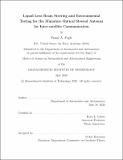| dc.contributor.advisor | Kerri L. Cahoy. | en_US |
| dc.contributor.author | Fogle, Faisal A.(Faisal Adam) | en_US |
| dc.contributor.other | Massachusetts Institute of Technology. Department of Aeronautics and Astronautics. | en_US |
| dc.date.accessioned | 2020-09-03T17:45:43Z | |
| dc.date.available | 2020-09-03T17:45:43Z | |
| dc.date.copyright | 2020 | en_US |
| dc.date.issued | 2020 | en_US |
| dc.identifier.uri | https://hdl.handle.net/1721.1/127076 | |
| dc.description | Thesis: S.M., Massachusetts Institute of Technology, Department of Aeronautics and Astronautics, May, 2020 | en_US |
| dc.description | Cataloged from the official PDF of thesis. | en_US |
| dc.description | Includes bibliographical references (pages 105-106). | en_US |
| dc.description.abstract | We investigate the feasibility of using a series of deformable liquid lenses to achieve wide-angle beam steering for CubeSat laser communication (lasercom) crosslinks. Liquid lenses are lenses that can non-mechanically alter focal length based on an applied voltage or current. We evaluate two commercial liquid lens manufacturers, Corning Varioptic and Optotune. Corning Varioptic lenses rely on the principle of electrowetting for lens actuation, while Optotune lenses are driven by a voice coil. For steering, a liquid lens is placed offset from the optical axis. Varying the liquid lens focal length will cause the beam to steer in 1D by refraction, but also causes a change in beam divergence. Adding an on-axis focusing liquid lens allows this beam divergence to be controlled dynamically. Adding a second off-axis liquid lens, displaced in the other axis, creates 2D steering. A fisheye lens can then amplify the steering cone to full hemispherical coverage [1]. | en_US |
| dc.description.abstract | However, liquid lenses were not designed for nor have ever been flown in space. In this work, we show that both types of liquid lens passed initial space qualification testing. Testing activities included vacuum survivability, vacuum operation, and thermal-vacuum (TVAC). The Corning A39N0 and Optotune EL-16-40-TC liquid lenses provided nearly identical steering transfer functions in vacuum as in ambient. The Corning and Optotune lenses achieved 2.7° and 8.6° angular range with collimated output, respectively, although these ranges were truncated by the camera field of view and focusing lens optical power range. The steering curves were linear, so, allowed to steer their full range, approximately 4.3° and 21.5° of steering range can be expected. In TVAC, the Corning lens operated from -25°C to 75°C and the Optotune lens from -40°C to 70°C. The lenses never failed in this testing, rather, external factors forced the termination of testing. | en_US |
| dc.description.abstract | Thus, even more temperature range may be expected. The lens steering angles drifted with temperature at 0.24 mrad/°C for the A39N0 and 0.19 mrad/°C for the EL-16-40-TC. The worst case hysteresis error, the difference in the steering transfer function between increasing and decreasing input values, was 0.3 mrad for the Corning lens and 1 mrad for the Optotune lens. A beam quality analysis was conducted in Zemax to identify the impact of beam refraction through the liquid lenses on transmit gain. Worst case values for transmit losses were found to be -0.5 dB for the Corning lens and -0.4 dB for the Optotune lens. However, at positive steering angles, an overall transmit boost can be expected due to the impact of beam expansion through the focusing liquid lens. We discuss key terminal design trade-offs, and a prototype transmit-only terminal was created and demonstrated full hemispherical steering in a lab setting. | en_US |
| dc.description.abstract | Future testing will investigate the beam quality and divergence for wide angle steering to quantify link distances for free space optical communications using this method of beam steering. A compact hemispherical laser transceiver will enable efficient, high data rate lasercom for small satellites. | en_US |
| dc.description.statementofresponsibility | by Faisal A. Fogle. | en_US |
| dc.format.extent | 106 pages | en_US |
| dc.language.iso | eng | en_US |
| dc.publisher | Massachusetts Institute of Technology | en_US |
| dc.rights | MIT theses may be protected by copyright. Please reuse MIT thesis content according to the MIT Libraries Permissions Policy, which is available through the URL provided. | en_US |
| dc.rights.uri | http://dspace.mit.edu/handle/1721.1/7582 | en_US |
| dc.subject | Aeronautics and Astronautics. | en_US |
| dc.title | Liquid lens beam steering and environmental testing for the miniature optical steered antenna for inter-satellite communication | en_US |
| dc.type | Thesis | en_US |
| dc.description.degree | S.M. | en_US |
| dc.contributor.department | Massachusetts Institute of Technology. Department of Aeronautics and Astronautics | en_US |
| dc.identifier.oclc | 1191819772 | en_US |
| dc.description.collection | S.M. Massachusetts Institute of Technology, Department of Aeronautics and Astronautics | en_US |
| dspace.imported | 2020-09-03T17:45:43Z | en_US |
| mit.thesis.degree | Master | en_US |
| mit.thesis.department | Aero | en_US |
